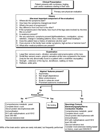Distal Symmetric Polyneuropathy: A Review
- PMID: 26599185
- PMCID: PMC5125083
- DOI: 10.1001/jama.2015.13611
Distal Symmetric Polyneuropathy: A Review
Abstract
Importance: Peripheral neuropathy is a highly prevalent and morbid condition affecting 2% to 7% of the population. Patients frequently experience pain and are at risk of falls, ulcerations, and amputations. We aimed to review recent diagnostic and therapeutic advances in distal symmetric polyneuropathy, the most common subtype of peripheral neuropathy.
Observations: Current evidence supports limited routine laboratory testing in patients with distal symmetric polyneuropathy. Patients without a known cause should undergo a complete blood cell count, comprehensive metabolic panel, vitamin B12 measurement, serum protein electrophoresis with immunofixation, fasting glucose measurement, and glucose tolerance test. The presence of atypical features such as asymmetry, non-length dependence, motor predominance, acute or subacute onset, and prominent autonomic involvement should prompt a consultation with a neurologist or neuromuscular specialist. Electrodiagnostic tests and magnetic resonance imaging of the neuroaxis contribute substantial cost to the diagnostic evaluation, but evidence supporting their use is lacking. Strong evidence supports the use of tricyclic antidepressants, serotonin norepinephrine reuptake inhibitors, and voltage-gated calcium channel ligands in the treatment of neuropathic pain. More intensive glucose control substantially reduces the incidence of distal symmetric polyneuropathy in patients with type 1 diabetes but not in those with type 2 diabetes.
Conclusions and relevance: The opportunity exists to improve guideline-concordant testing in patients with distal symmetric polyneuropathy. Moreover, the role of electrodiagnostic tests needs to be further defined, and interventions to reduce magnetic resonance imaging use in this population are needed. Even though several efficacious medications exist for neuropathic pain treatment, pain is still underrecognized and undertreated. New disease-modifying medications are needed to prevent and treat peripheral neuropathy, particularly in type 2 diabetes.
Figures

Comment in
-
Leprosy as a Cause of Distal Symmetric Polyneuropathy.JAMA. 2016 May 17;315(19):2123. doi: 10.1001/jama.2016.1112. JAMA. 2016. PMID: 27187310 No abstract available.
-
Leprosy as a Cause of Distal Symmetric Polyneuropathy--Reply.JAMA. 2016 May 17;315(19):2123-4. doi: 10.1001/jama.2016.1118. JAMA. 2016. PMID: 27187311 No abstract available.
References
-
- Bharucha NE, Bharucha AE, Bharucha EP. Prevalence of peripheral neuropathy in the Parsi community of Bombay. Neurology. 1991 Aug;41(8):1315–1317. - PubMed
-
- Savettieri G, Rocca WA, Salemi G, et al. Prevalence of diabetic neuropathy with somatic symptoms: a door-to-door survey in two Sicilian municipalities. Sicilian Neuro-Epidemiologic Study (SNES) Group. Neurology. 1993 Jun;43(6):1115–1120. - PubMed
-
- Chronic symmetric symptomatic polyneuropathy in the elderly: a field screening investigation in two Italian regions. I. Prevalence and general characteristics of the sample. Italian General Practitioner Study Group (IGPSG) Neurology. 1995 Oct;45(10):1832–1836. - PubMed
-
- Rudolph T, Farbu E. Hospital-referred polyneuropathies--causes, prevalences, clinical- and neurophysiological findings. Eur J Neurol. 2007 Jun;14(6):603–608. - PubMed
-
- Visser NA, Notermans NC, Linssen RS, van den Berg LH, Vrancken AF. Incidence of polyneuropathy in Utrecht, the Netherlands. Neurology. 2015 Jan 20;84(3):259–264. - PubMed
Publication types
MeSH terms
Substances
Grants and funding
LinkOut - more resources
Full Text Sources
Other Literature Sources

